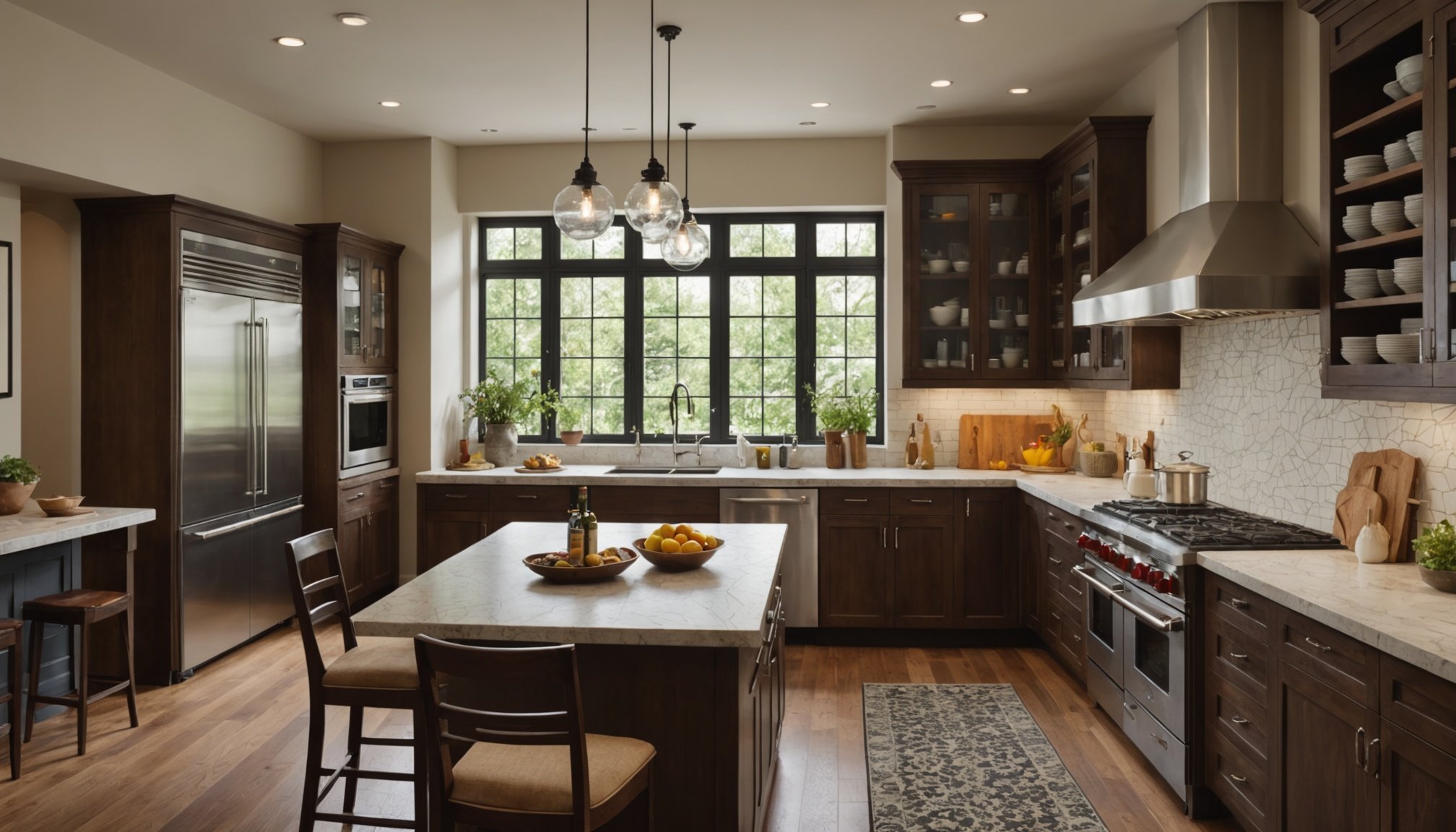Culturally-Inspired Kitchen Design
Creating a culturally-inspired kitchen involves embracing the rich diversity found across the globe to craft a unique and welcoming space. Selecting a theme that celebrates multiple cultures makes your kitchen a melting pot of global flavours and design tips.
Begin by choosing a theme that reflects various cultural influences. Whether it’s the elegance of Japanese minimalism or the bold colours of Mexico, incorporating aspects from different cultures adds a personal touch to your kitchen.
Have you seen this : Create an easy-care kitchen: smart strategies for stress-free cleaning and maintenance
When it comes to design tips, consider the colours and materials that best represent your selected cultures. For instance, African design often utilises earth tones and natural materials like wood and stone, while Indian interiors might feature more vibrant hues like saffron or turquoise, alongside intricate patterns.
Layouts play a significant role in culturally-inspired designs. Nordic cultures favour open, airy spaces with functional designs, whereas Mediterranean kitchens often showcase rustic warmth with elements like terracotta tiles and wrought iron.
Also read : Designing an ideal farm-to-table kitchen: fresh ideas for eco-friendly living
Incorporate culturally-specific design elements into cabinetry and textiles. Moroccan-inspired cabinetry may feature ornate carvings, while textiles from Peru can add vibrant, handwoven patterns to your decor. This thoughtful blend of global elements ensures your kitchen is both culturally authentic and aesthetically pleasing.
Integrating Cultural Elements into Kitchen Spaces
Bringing cultural elements into your kitchen decoration can beautifully showcase global influences. By weaving in charming details from different cultures, your kitchen can transform into a space that tells a rich story of heritage and tradition.
Art and Decor
Utilising artwork and handicrafts from diverse cultures provides a unique touch. By incorporating cultural motifs and symbols, you can design a kitchen decor steeped in authenticity. Consider, for instance, elaborate pottery from Mexico or delicate ceramics from Japan – each piece narrates a tale of its origins.
Textiles and Color Palettes
Selecting fabrics inspired by various cultures enriches the ambience. Think of vibrant Indian mandalas or African prints, which bring a fresh vibrancy to your kitchen. Colour schemes, too, express global influences. Use warm tones symbolising the Mediterranean or cool shades echoing Scandinavian landscapes to enhance your space.
Functional Elements
An adaptation of traditional cookware adds an element of practicality. Imagine cooking with a Moroccan tagine or a Chinese wok. These tools not only perform specific culinary tasks with ease but also embody their culture’s essence. Furthermore, creating multi-functional spaces allows you to explore diverse culinary techniques, making the kitchen not just a functional area, but a cultural hub.
Kitchen Layouts for Global Cooking
Selecting the right kitchen layout is crucial when embracing global culinary traditions. Each culture brings its unique cooking style, requiring different space arrangements. Let’s explore the best layouts for accommodating diverse cooking styles, ensuring workflow efficiency in a world kitchen.
For those who indulge in rich international cooking, the U-shaped and L-shaped kitchen layouts are often recommended. These designs provide sufficient countertop space, allowing multiple people to work simultaneously, perfect for complex dishes like sushi or paella that require precise preparation steps. Such arrangements enhance workflow efficiency, a vital component when orchestrating elaborate international recipes.
The concept of workflow efficiency in the kitchen goes beyond just having space. It’s about having the right things in the right places. For instance, installing distinct zones for chopping, mixing, and cooking, allows seamless transitions between each phase of cooking, eliminating unnecessary movement.
The issue of space is particularly significant in multi-generational or multi-cultural settings. These kitchens often serve as a communal hub, where culinary traditions are shared and passed on. Thus, an open or island layout could also be ideal, providing flexibility and accessibility for all family members, regardless of their cultural background.
Essential Kitchen Tools for Diverse Cuisines
Cooking international dishes at home requires a range of kitchen tools that support diverse culinary styles. It’s not just about the basics; certain cuisines demand specialized equipment to capture their authentic flavours and textures.
Must-Have Cookware
For those delving into international cooking, understanding the essential cookware linked to specific cultural cuisines is crucial. Traditional Japanese meals, for instance, benefit from having items like an iron teapot for brewing loose-leaf teas and a wok for stir-frying.
In contrast, conventional cooking tools like regular frying pans or saucepans might not suffice when aiming for authenticity. Specialized utensils such as clay pots for Indian dishes allow for the slow, even cooking necessary for developing rich flavours.
Functional diversity in equipment enables you to experiment with a variety of recipes and techniques. Investing in a few key pieces of cookware suited to your favourite global cuisines can make a substantial difference.
By expanding your collection to include both traditional and specialized cooking tools, you can embrace the unique culinary practices of different regions, enhancing your kitchen’s versatility and your cooking repertoire.
Recipes that Celebrate Culinary Diversity
Embrace the world of global recipes to transform your kitchen into an arena of culinary exploration. By experimenting with diverse flavors, you bring the essence of faraway lands to your dining table, celebrating both familiar and unfamiliar cultures.
Signature Dishes Across the Globe
Start with signature dishes that highlight the unique characteristics of their traditions. Picture crafting a comforting Italian risotto, which delights with a perfect blend of creamy arborio rice and seasonal elements like asparagus. Perhaps try a fragrant Thai green curry, harmonising coconut, lemongrass, and kaffir lime leaves into a symphony of flavors.
Adding a Seasonal Flair
Introducing seasonal elements can significantly elevate these delicious explorations. For example, include autumnal squashes in Moroccan tagine, or springtime strawberries in Japanese daifuku. The concept of embedding seasonal highlights ensures that dishes remain fresh and relevant throughout the year.
Harmonious Flavour Combinations
The secret lies in balancing flavors, where even a pinch of spice can reveal new culinary experiences. A dash of za’atar in Mediterranean salads or a sprinkle of sumac in Middle Eastern cuisine can transform your meal into an engaging sensory journey. Through mindful flavor combinations, global recipes produce a genuine celebration of diversity and taste.
Visual Inspiration for Designing Your Kitchen
When envisioning your dream kitchen, cultural inspiration can infuse your space with character and charm. Exploring inspiring kitchen designs that reflect diverse cultures not only elevates aesthetic appeal but also enriches the cooking experience. By integrating global styles, you can create a kitchen that’s both functional and unique.
Gallery of Culturally-Inspired Kitchens
Explore this gallery of kitchens where culture-inspired aesthetics breathe life into the heart of your home. Discover a Japanese-inspired kitchen featuring minimalist lines and natural materials, a tribute to simplicity and balance. Imagine the warmth of a Mediterranean-style kitchen, adorned with vibrant tiles and wrought iron fixtures, evoking the sun-soaked coastlines of Southern Europe. Each design choice contributes to a culturally-rich environment, inviting you to savour the essence of different worlds.
Transformative Before and After
Visualise the profound transformation as a standard kitchen is redesigned to reflect cultural diversity. The inclusion of distinct elements, like traditional Moroccan mosaics or Scandinavian wooden textures, showcases the significance of personalization. Crafting a kitchen with culture-inspired aesthetics allows homeowners to curate a space that resonates with their heritage or aspirations, creating a unique cooking space that feels genuinely personal.
Real-Life Experiences
Hear from individuals who have embraced cultural diversity in their kitchens. Sarah, an avid traveller, shares how incorporating Indian spices and accessories altered her cooking habits, fostering creativity and exploration. These stories illustrate how integrating global influences can transform daily culinary experiences, making them more enjoyable and enriching.










